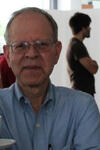Michael Dine
The interactions of heavy quarks in quantum chromodynamics (QCD) are analyzed in detail. The problem of extracting instanntaneous interaction potentials from quantum field theory is first reviewed, in the context of simple models. We indicate how such a potential for a fermion-antifermion system may be extracted from the Bethe-Salpeter equation or from on-shell scattering amplitudes. For a simple Abelian model, we argue that the static potential may be obtained by considering the fermion-anti-fermion pair to be static sources, fixed in space. This leads us to Wilson’s loop integral and the Feynman-Kac formula as devices for computing the potential. The validity of this procedure is seen to follow from the fact that the processes contributing to the potential are fast on the scale of quark motion. We give a simple prescription for the computation of the potential.
After reviewing the quantization of non-Abelian gauge theories in Coulomb gauge, the interaction of a heavy quark-antiquark (QQ) pair is considered. We derive a Ward identity relating the Coulomb-gluon-fermion vertex to the fermion self-energy. This identity is used to prove the mass independence of the static potential. We then demonstrate that the potential is infrared finite through two loops, and indicate its general structure in perturbation theory. At three loops, divergences associated with long-lived intermediate states appear. We show how to resolve this problem for static sources, but the result cannot readily be identified as a potential appropriate to the description of a QQ bound state. This problem is discussed in detail.
We then analyze the spin-dependent interactions in these systems. We show that the spin-dependent potentials depend in a non-trivial way on the quark mass. This dependence arises from processes taking place at distances on the order of the quark Compton wavelength. The phenomenological implications of these results are considered.
We conclude by discussing the implications of our results for non-perturbative attacks on the potential problem. The importance of source-field correlations is stressed. Self consistency criteria are given which any computation of an instantaneous potential must satisfy. The limitations of schemes which have been introduced recently to compute spin-dependent forces due to instantons are illustrated.
